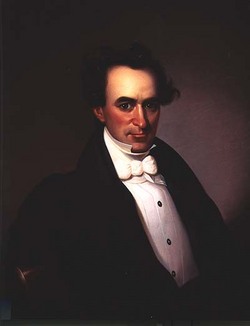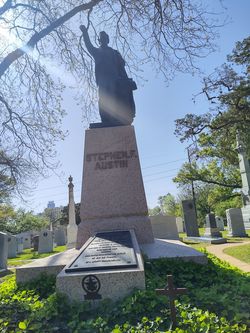![]()
By Tracy Gupton
Columbia Historical Museum Secretary
As children growing up in West Columbia, my cousin Steve Weems and I would often ride horses and mini-bikes in the big pasture of Phil Gupton’s that included cattle-grazing land adjoining the old oil fields outside of town. We could open a gate at the back of Steve’s grandfather’s pasture and continue our adventures on to land where the old McKinstry place existed in early Republic of Texas days.
This was the time of year in late 1836 when Stephen Fuller Austin, “The Father of Texas,” died at this same location on December 27th, not very far from where my wife and our son and I live today. Austin and other early Texan settlers were still basking in the glory of winning their independence from Mexico at the Battle of San Jacinto in April of 1836 when the new Republic of Texas’s government was in its infancy.
Austin had run unsuccessfully for president of the new republic earlier the year he died, losing to Sam Houston, the heroic general who led the Texian soldiers to victory at San Jacinto. Sam Houston had appointed Stephen F. Austin secretary of state after being sworn in as the Republic of Texas’s first president when Columbia (now the town of West Columbia) was the capital city of Texas.
“Houston and Austin had been competitors at times,” it was written in Texas History Notebook, a blog about the Lone Star State. “But they also appear to have remained personally cordial, if not even friendly.”

There is a replica of the first capital building of the Republic of Texas for tourists to visit near West Columbia City Hall and adjacent to the local American Legion Post. But in 1836, when Sam Houston and Stephen F. Austin were living in Columbia, the actual first capital building was situated near where the West Columbia Walgreens is now. A concrete monument in the Walgreens parking lot marks the spot where Austin and Houston worked diligently alongside others to conduct daily business aimed at keeping the new republic’s affairs in order. For a few months earlier Texas was still officially under Mexican rule.
Stephen F. Austin had been renting a room from George McKinstry a couple miles from the capital building, which in reality (if you have seen the replica behind Prosperity Bank you know how small it is) was just a log cabin. These living conditions, which made it somewhat convenient for Austin to perform his duties as secretary of state, may have been acceptable in normal southeast Texas weather, but failed to provide the necessary protection for a man in compromised health when harsher conditions occurred.
Austin had served an extensive jail sentence in Mexico under deplorable conditions while Texans were making progress settling more and more of the country Austin had led American settlers to. Austin, born in 1793 in Virginia as the son of Moses and Mary Brown Austin, first arrived in the Eastern portion of Mexico that is now Texas in August 1821.
He spent a year in prison in Mexico City after encouraging Texans to form an independent state government, a move Mexican President Antonio Lopez de Santa Anna deemed treason. Austin was eventually allowed to return to Texas in 1835.

With weather conditions in December 1836 similar to the recent hard freeze experienced by present-day West Columbians, Stephen F. Austin caught a severe cold working in the old capital building at Columbia. His cold quickly turned into pneumonia. Austin was living in a side room attached to George McKinstry’s cabin that had no stove or fireplace and his bout with pneumonia rapidly worsened.
A “blue norther” had hit the Columbia area, further aggravating Austin’s chronic respiratory condition. While resting at the McKinstry home, Austin was cared for by Dr. Branch Tanner Archer. After showing slight improvement on Christmas Day, Austin’s illness worsened and he died at the age of 43 late in the evening of December 27, 1836.
It has been reported that among Austin’s final words, uttered to Dr. Archer and Austin’s brother-in-law, James Perry, were, “Now, I will go to sleep.”
He could only talk in whispers due to his extremely weakened state. After several hours of unconsciousness and deep sleep, “The Father of Texas” awoke around 11:30 at night and, in a faint voice, said, “The independence of Texas is recognized! Don’t you see it in the papers. Dr. Archer told me so!”
Austin slipped back off to sleep and, about a half hour later, died. He had only served three months as the Republic of Texas’s first secretary of state.
I often walk around my pasture near my West Columbia home, my own personal patch of blue, and gaze out across the cattle pasture adjoining my family’s land, realizing that the likes of great early Texas heroes like Sam Houston and Stephen F. Austin most likely rode their horses or walked over this same property – located directly between where the home of George McKinstry and the first capital building of the Republic of Texas once were – and find myself impressed that I have been blessed to have grown up in such an important little town that played a huge role in Texas’s great history.

Emily Austin Bryan Perry arranged for her brother, Stephen F. Austin, to be buried at Gulf Prairie Cemetery, about 17 miles to the southeast of Columbia in what today is known as Jones Creek, across the road from the Gulf Prairie Presbyterian Church. Emily’s daughter, Mary Elizabeth (Stephen F. Austin’s 11-year-old niece), had died three years earlier, possibly of cholera, and had been buried there. Numerous others in the Bryan family would later be laid to rest there too.
General Sam Houston, president of the Republic of Texas, attended Austin’s funeral and burial service. It has been reported that the body of Stephen F. Austin was transported by boat from East Columbia (then known as Marion or Bell’s Landing) down the Brazos River to a location near his sister’s plantation, where the casket was placed on a horse-drawn wagon near the banks of the Brazos and carried across land to the burial site.
At the graveside Sam Houston spoke to the friends and Austin family members. The Texas President’s closing remarks were, “The father of Texas is no more.”
Austin’s remains were removed from the Gulf Prairie Cemetery in Jones Creek in 1910 and moved to the Texas State Cemetery in Austin, the city that bears his name and has long been the capital of Texas. Columbia only remained the capital of the Republic of Texas until 1837 when the new city named after Sam Houston replaced Columbia. By 1850 Austin had replaced Houston as Texas’s capitol city.
In 1910 Texas Governor Oscar Branch Colquitt commissioned a statue of Stephen F. Austin by the sculptor Pompeo Coppini to be mounted on a granite monument at the site of Austin’s grave at the Texas State Cemetery. In 1936 Texas Governor James V. Allred authorized a granite marker in the West Columbia oil fields at the site where Austin died, in connection with the Texas Centennial. This historic site eventually fell into disrepair but it was restored in the 1990s by a Houston businessman.
A rededication ceremony was held in 1994. Reenactments of the original funeral procession for Stephen F. Austin have been held on many occasions in recent years at Gulf Prairie Cemetery in Jones Creek.
One feature of the reenactments is a 23-gun salute, as opposed to the more familiar military 21-gun salute. This practice originated with Sam Houston who had ordered 23 guns to be fired to commemorate the number of counties that existed in Texas at the time of Stephen F. Austin’s death at this time of year 186 years ago.
